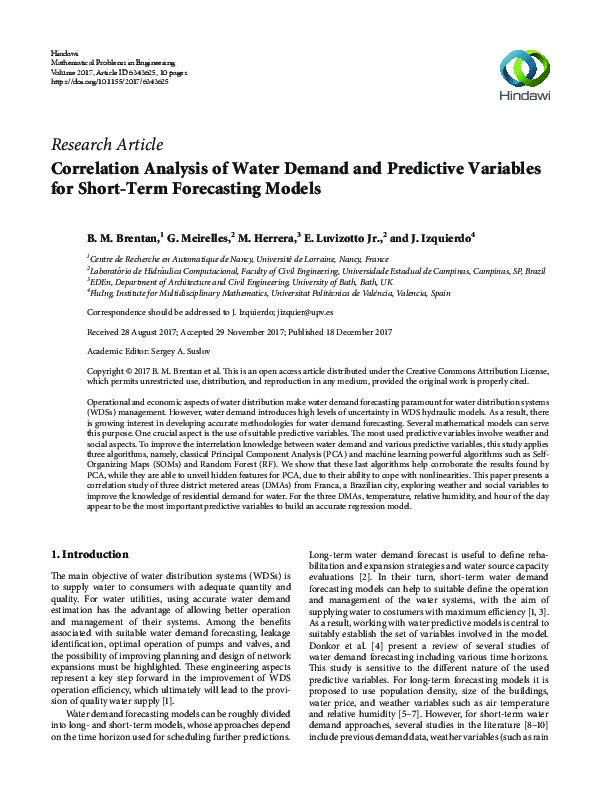JavaScript is disabled for your browser. Some features of this site may not work without it.
Buscar en RiuNet
Listar
Mi cuenta
Estadísticas
Ayuda RiuNet
Admin. UPV
Correlation analysis of water demand and predictive variables for short-term forecasting models
Mostrar el registro sencillo del ítem
Ficheros en el ítem
| dc.contributor.author | Brentan, B. M.
|
es_ES |
| dc.contributor.author | Meirelles, G.
|
es_ES |
| dc.contributor.author | Herrera Fernández, Antonio Manuel
|
es_ES |
| dc.contributor.author | Luvizotto, E., Jr.
|
es_ES |
| dc.contributor.author | Izquierdo Sebastián, Joaquín
|
es_ES |
| dc.date.accessioned | 2018-06-01T04:19:13Z | |
| dc.date.available | 2018-06-01T04:19:13Z | |
| dc.date.issued | 2017 | es_ES |
| dc.identifier.issn | 1024-123X | es_ES |
| dc.identifier.uri | http://hdl.handle.net/10251/103123 | |
| dc.description.abstract | [EN] Operational and economic aspects of water distribution make water demand forecasting paramount for water distribution systems (WDSs) management. However, water demand introduces high levels of uncertainty in WDS hydraulic models. As a result, there is growing interest in developing accurate methodologies for water demand forecasting. Several mathematical models can serve this purpose. One crucial aspect is the use of suitable predictive variables. The most used predictive variables involve weather and social aspects. To improve the interrelation knowledge between water demand and various predictive variables, this study applies three algorithms, namely, classical Principal Component Analysis (PCA) and machine learning powerful algorithms such as Self-Organizing Maps (SOMs) and Random Forest (RF). We show that these last algorithms help corroborate the results found by PCA, while they are able to unveil hidden features for PCA, due to their ability to cope with nonlinearities. This paper presents a correlation study of three district metered areas (DMAs) from Franca, a Brazilian city, exploring weather and social variables to improve the knowledge of residential demand for water. For the three DMAs, temperature, relative humidity, and hour of the day appear to be the most important predictive variables to build an accurate regression model. | es_ES |
| dc.language | Inglés | es_ES |
| dc.publisher | Hindawi Limited | es_ES |
| dc.relation.ispartof | Mathematical Problems in Engineering | es_ES |
| dc.rights | Reconocimiento (by) | es_ES |
| dc.subject.classification | MATEMATICA APLICADA | es_ES |
| dc.title | Correlation analysis of water demand and predictive variables for short-term forecasting models | es_ES |
| dc.type | Artículo | es_ES |
| dc.identifier.doi | 10.1155/2017/6343625 | es_ES |
| dc.rights.accessRights | Abierto | es_ES |
| dc.contributor.affiliation | Universitat Politècnica de València. Instituto Universitario de Matemática Multidisciplinar - Institut Universitari de Matemàtica Multidisciplinària | es_ES |
| dc.contributor.affiliation | Universitat Politècnica de València. Departamento de Matemática Aplicada - Departament de Matemàtica Aplicada | es_ES |
| dc.description.bibliographicCitation | Brentan, BM.; Meirelles, G.; Herrera Fernández, AM.; Luvizotto, EJ.; Izquierdo Sebastián, J. (2017). Correlation analysis of water demand and predictive variables for short-term forecasting models. Mathematical Problems in Engineering. (6343625):1-10. doi:10.1155/2017/6343625 | es_ES |
| dc.description.accrualMethod | S | es_ES |
| dc.relation.publisherversion | https://doi.org/10.1155/2017/6343625 | es_ES |
| dc.description.upvformatpinicio | 1 | es_ES |
| dc.description.upvformatpfin | 10 | es_ES |
| dc.type.version | info:eu-repo/semantics/publishedVersion | es_ES |
| dc.description.issue | 6343625 | es_ES |
| dc.relation.pasarela | S\349059 | es_ES |








